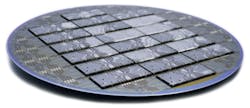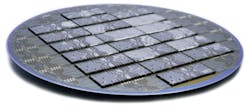Collaboration Drives Life Science Research
The Flemish nanotechnology research organization imec has been addressing medical and life-science breakthroughs on several fronts with a variety of commercial and university partners. In the fourth quarter of last year alone, imec announced three significant initiatives: to partner with JSR to develop lab-on-chip cell-sorter devices, to explore clinical lab-on-chip applications in conjunction with Johns Hopkins University, and to establish a life-sciences supercomputing lab in conjunction with Intel, Janssen Pharmaceuticals, and five Flemish universities.
Lab-on-Chip
Lab-on-chip technology has been a particular focus of imec and its partners, with emphasis on both the fabrication of lab-on-chip devices and on their clinical applications. Lab-on-chip technology, imec reported, will drive a revolution in medical technology, enabling point-of-care diagnosis and treatment through on-chip molecular synthesis, separation, sensing, and detection—all outside of a traditional medical laboratory setting. Challenges facing imec and its partners as they try to fabricate these devices center on the capability to cost-effectively integrate microfluidics with heterogeneous components such as electronics, sensors, microheaters, and photonics. To merge these elements successfully, new bonding and surface-treatment materials are needed, imec said.
Last summer, imec and Panasonic announced that they had jointly developed a fully integrated silicon chip about half the size of a credit card that performs fast, simple, and sensitive detection of genetic markers—specifically single nucleotide polymorphisms (SNPs), as described in an earlier article.1 The chip integrates a variety of structures and sample preparation modules, including microfluidic conduits, filters, mixers, and miniaturized polymerase chain reaction cyclers and sensing elements, onto a single disposable device.
More recently, imec has teamed up with JSR, which makes electronics materials, to address lab-on-chip fabrication challenges. The organizations announced in November that they have used JSR’s Photopatternable Adhesive (PA) material for wafer-scale processing of lab-on-chip devices (Figure 1). With PA as a key enabling material, imec said it has processed microfluidic cell-sorter devices, merging microheaters and sensors with wafer-scale polymer microfluidics. PA, imec said, is simultaneously a good microfluidic channel material and adhesive suitable for wafer-scale processes and mass production.
Courtesy of imec
“PA solves a number of issues that we have with other materials, such as the widely used polydimethylsiloxane (PDMS), a silicon-based organic polymer,” said Liesbet Lagae, imec R&D manager of life-science technologies. “It has all the characteristics we are looking for in a photopatternable material to create microfluidic channels on silicon wafers, including good channel definition and biocompatibility. But at the same time, it is an adhesive that allows direct thermal bonding with the cover glass. And unlike PDMS, it allows for wafer-scale processing, which is a prerequisite for industrial mass production.”2
imec has used PA to process the next generation of its cell-sorter lab-on-chip. A prototype lab-on-chip integrates on-chip imaging, in-flow cell tomography to identify cells, and bubble-jet flow technology to guide and sort individual cells; it can process up to 2,000 cells per second. One application envisaged for these ultrafast cell-sorters is the detection of circulating tumor cells in human blood.
JSR and imec have been partners in the development of semiconductor technology and materials going back to the late 1980s. JSR began developing microfluidics materials in partnership with imec starting in 2011. Two years of R&D, including the assessment of biocompatibility and process compatibility, now have resulted in a material solution for labs-on-chip such as imec’s cell-sorter.
Luc Van den hove, president and CEO of imec, said, “JSR now has also become a key material supplier in the life-science ecosystem. Together, JSR and imec will continue to develop material solutions for life-science applications.”
JSR’s CEO Nobu Koshiba added, “Most applications face the challenge of selecting the right materials and technologies. Our collaboration with imec proves that open innovation is key to move from early-stage precompetitive technology to the development of robust products such as these next-generation medical devices.”2
For its part, JSR has been involved in life-sciences initiatives apart from its cooperation with imec. Last August, JSR and SCIVAX Life Sciences entered into a strategic partnership to develop and expand their three-dimensional cell-culture business. JSR became a minority owner in SCIVAX and will sell its products to the global market via JSR’s global network including JSR Life Sciences in Japan/Asia, JSR Micro in the United States, and JSR Micro N.V. in Europe.
SCIVAX Life Sciences’ product NanoCulture Plate has been used at pharmaceutical companies and academic institutions for drug discovery research, mainly in Japan and the United States. JSR reports that 3-D cultured spheroids are expected to accelerate further advancements in the understanding of the mechanisms of disease, in developing treatments, and in furthering drug discovery. NanoCulture Plate now is used primarily for cancer research but has potential to be expanded into other areas such as testing anticancer drug sensitivities, the company reported.
Silicon Nanotech Healthcare
In efforts to apply its lab-on-chip technology in clinical settings, imec said its researchers and physicians at Johns Hopkins University will collaborate to advance silicon applications in healthcare, beginning with development of a lab-on-chip device to enable a broad range of clinical tests to be performed outside the laboratory. The collaboration will combine Johns Hopkins’s clinical and research expertise with imec’s nanoelectronics capabilities. The two organizations plan to forge strategic ties with additional collaborators in the healthcare and technology sectors, the organizations reported.
imec and Johns Hopkins University say they hope to develop the next generation of lab-on-chip concepts based on imec technology. They envision a disposable chip that could be loaded with a sample of blood, saliva, or urine and then quickly analyzed using a smartphone, tablet, or computer, making diagnostic testing faster and easier for applications such as disease monitoring and management, disease surveillance, rural healthcare, and clinical trials. Compared with the current system of sending samples to a laboratory for testing, such an advance would be “the healthcare equivalent of transforming a rotary telephone into the iPhone,” said Drew Pardoll, M.D., Ph.D., the Martin Abeloff Professor of Oncology. Pardoll leads the advisory board for the Johns Hopkins-imec collaboration, which will work to extend new applications of silicon nanotechnology into multiple areas of medicine.
“Johns Hopkins has always prioritized innovative and transformative research opportunities,” said Landon King, M.D., the David Marine Professor of Medicine and executive vice dean of the school of medicine. “Our new collaboration with imec is such an opportunity, and we very much look forward to leveraging our respective strengths across the university in biomedical and nanotechnology research to improve patient diagnosis and care throughout the world.”3
Rudi Cartuyvels, senior vice president of smart systems at imec, added, “The unique combination of imec’s nanoelectronics expertise with Johns Hopkins’ proven medical sciences and clinical expertise will enable us to jointly develop game-changing solutions for more effective healthcare.”
Lab-on-Campus
Lab-on-chip isn’t the only focus of imec’s life-sciences initiatives. Lab-on-campus might be a more appropriate name for an initiative involving imec, Intel, Janssen Pharmaceuticals, and five Flemish universities (UA, UGhent, KULeuven, UHasselt, and VUB). These organizations have established the ExaScience Life Lab on the imec campus in Leuven, Belgium. The ExaScience Life Lab will combine Intel’s supercomputing expertise with Flanders’ expertise in life sciences and biotechnology, imec reported. The objective of the collaboration is to create new supercomputer solutions and generate breakthroughs in life sciences and biotechnology.
Initially, the lab will focus on two fields of application. First, the lab will examine how supercomputers can accelerate the processing of entire genome sequences. Today, imec reported, such an analysis takes approximately 48 hours, and with the expected explosion of genome data becoming available in the coming years, it is crucial to improve the efficiency of the computing process. A second application area of the ExaScience Life Lab will be to examine the use of computer simulations in the life sciences. Testing hypotheses through computer simulation of both cells and tissues instead of through wet-lab testing saves time and cost associated with lab tests.
The ExaScience Life Lab is an extension of Intel’s ExaScience Lab for High Performance Computing opened at imec in 2010. When that lab was founded, Intel said its goal was “…to achieve breakthroughs in power reduction and reliability, an effort critical to extend today’s supercomputer architecture to exascale levels of performance, or speeds 1,000 times faster than today’s supercomputers.” That lab’s applications have included predicting “space weather” and its effects relative to safety and security on Earth.
“Intel has an extensive network of research laboratories in Europe. Once operational, the ExaScience Life Lab will be our European centre of excellence for high-performance computing in the life sciences,” said Intel lab manager Luc Provoost. “The collaboration with Janssen Pharmaceuticals should enable us to build even more powerful supercomputers. We expect the lab’s joint research and development efforts to lead to major breakthroughs in the use of supercomputing for bioscientific applications.”4
“It is our conviction that the ExaScience Life Lab will act as a catalyst in our aspiration to solve certain critical medical needs through technological innovation,” stated Gunaretnam Rajagopal, Janssen Pharmaceuticals’ head of computational sciences. “In the future, supercomputing will become a key force behind advances in life sciences.”
Flemish Minister of Innovation Ingrid Lieten pointed out that “Flanders enjoys an enviable reputation in the fields of life sciences, biotechnology, and high-performance computing with a research-driven industry and highly skilled knowledge workers. The ExaScience Life Lab will stimulate collaboration between various disciplines and between the academic and the corporate world. It will establish Flanders as a leading region for supercomputing in life sciences. To achieve this, the ExaScience Life Lab will work closely with the Flemish Supercomputer Centre.”
Van den hove at imec concluded, “We are very excited about this unique collaboration with leading international companies such as Intel and Janssen Pharmaceuticals and with the Flemish universities. I have every confidence that by pooling our resources and expertise, the ExaScience Life Lab will achieve excellent results that will stimulate research and development in the life sciences.”
References
1. Nelson, R., “imec, Panasonic Collaborate on SNP Detection,” EE-Evaluation Engineering, August 2013, p. 14.
2. “JSR, imec Demonstrate Microfluidic Material for Lab-on-Chip,” EE-Evaluation Engineering Online, Nov. 4, 2013.
3. “Imec and Johns Hopkins Expand Silicon Nanotech Healthcare,” EE-Evaluation Engineering Online, Oct. 24, 2013.
4. “ExaScience Life Lab to Target Supercomputing, Biotechnology,” EE-Evaluation Engineering Online, Oct. 7, 2013.

